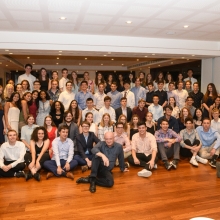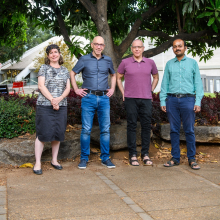Cellular chitchat
Dr. Yaron Antebi is unlocking the mystery of how cells communicate
New scientists

While studying physics at the Weizmann Institute, Dr. Yaron Antebi became captivated by exciting developments in biology. Radically changing course towards the end of his graduate work, he began to apply the strengths he developed in understanding string theory and physics to the challenges of deciphering how cells communicate.
A new recruit to the Department of Molecular Genetics, Dr. Antebi is the latest Weizmann scientist to bring to bear his training and expertise in physics to the life sciences.
It turns out that cells talk—in their own way. Just as humans use letters to create words and messages, cells release molecules called ligands into the environment to send information to their neighbors. These ligands bind to receptors on the surface of other cells, which interpret the messages and trigger the appropriate response.
Under traditional models of cellular communications, each ligand was thought to serve as a key to opening a specific receptor lock. However, scientists realized that it is not that simple. In fact, it is a bit of mayhem: many different ligands appear to interact with many different receptors. In this way, communication between cells is like a conversation in a crowded room with everyone talking at once. This seems to complicate the ability of individual cells being able to properly interpret and respond to specific signals.
After studying as an undergraduate for a year at the Massachusetts Institute of Technology, Dr. Antebi completed a BSc in physics and mathematics magna cum laude at Tel Aviv University in 1998. During his PhD studies in high-energy theoretical physics at the Weizmann Institute with Profs. Ofer Aharony and Micha Berkooz in the Department of Particle Physics and Astrophysics, he was drawn to the study of string theory and supersymmetry. In a radical shift after completing his PhD in 2008, he focused his attention on cell biology.
It was then, as a postdoctoral fellow in Prof. Nir Friedman’s lab in the Department of Immunology, that he began learning the basic tools of immunology research in order to try to understand how conflicting signals are processed by the body’s T-cells. During this time, he also collaborated with another physicist-turned-biologist, Prof. Uri Alon of the Department of Molecular Cell Biology, contributing new insights into the study of the control circuits governing cell population size.
It was clear to him by this point that his chief interest was tackling the complexity of intercellular communication.
Continuing his postdoctoral research at the California Institute of Technology in biology and biological engineering, he eventually came to the surprising conclusion that cells aren’t communicating with individual ligands, but rather combinations of ligands. That understanding has given rise to a radical new paradigm for understanding how cells talk with each other.
Digging deeper, Dr. Antebi fused all of his areas of expertise, combining experimental biology with the mathematical modeling learned in his physics training. He has succeeded in showing something incredibly insightful: that cells respond to complex combinations of different ligands, rather than a single message, and also that different cell types can interpret the same set of signals in different ways. This view is a major departure from the conventional understanding of how cells communicate with each other—and provides a new foundation for understanding how information is communicated inherently through combinations of signaling molecules and their receptors.
“I was fascinated about the many things cells can become in our body: bone, muscle, brain, and much more, and how a cell knows which path to choose,” says Dr. Antebi. “It turns out that they can talk, in a language yet to be fully understood. When we get to the point where we understand how to construct ‘words’ in cellular language, we could potentially direct their behavior and thus correct undesired processes, construct specific tissues, or even create new synthetic cellular structures.”
Dr. Yaron Antebi is supported by The Abramson Family Center for Young Scientists, Clal Insurance, the Harmstieg New Scientist Fund, the Estate of David Levinson, The Jeanne and Joseph Nissim Center for Life Sciences Research, the Estate of Bella Ockman, the David M. Polen Charitable Trust, the Abraham & Sonia Rochlin Foundation, and the Ruth and Samuel J. Rosenwasser Charitable Fund.








